Spatiotemporal Evolution of Seasonal Crop-Specific Climatic Indices under Climate Change in Greece Based on EURO-CORDEX RCM Simulations
Abstract
1. Introduction
2. Data and Methods
2.1. Regional Climate Model Simulations
2.2. Critical Crop Periods—Crop- and Seasonal-Specific Climatic Indices
| Crop | Indices Related to Temperature | Season | Impact of Temperature Stress | |
|---|---|---|---|---|
| 1 | Wheat 1, Tomatoes 5, Cotton 8 | Days with TASMAX > 30 °C | Spring | Yield decrease (Wheat); fruit setting (Tomato); reduction in fruit retention (Cotton). |
| 2 | Wheat 2, Cotton 2, Potato 3, Tomatoes 3, Grapes 7 | Days with TASMIN < 0 °C (frost days) | Spring | Yield decrease (Wheat, Tomato, and Potato); plant issue damage (Grape); damage in germination percentage and seedling establishment (Cotton). |
| 3 | Wheat 9, Rice 11 | Days with TASMIN > 20 °C (tropical nights) | Spring–Summer | Decrease in grains per spike and grain size (Wheat); reduction in grain weight and growth rate (Rice). |
| 4 | Potato 4, Tomatoes 6, Grapes 7, Rice 10, Olive 12 | Days with TASMAX > 35 °C (hot days) | Summer | Tuber formation and yield (Potato); fruit setting (Tomato); yield decrease (Grape); growth rate decrease (Olive); growth rate and yield losses (Rice). |
| 1: [24]; 2: [23]; 3: [35]; 4: [34]; 5: [36]; 6: [37]; 7: [39]; 8: [32]; 9: [25]; 10: [40]; 11: [43]; 12: [28]. | ||||
| Crop | Indices Related to Precipitation | Season | Impact of Water Deficit | |
| 1 | Wheat 1, Tomatoes 1, Grapes 2 | Days with PR > 1 mm (wet days) | Spring | Flowering (Potato); shortened growth period and decreased yield (Wheat); early flowering (Grapes). |
| 2 | Potato 1, Tomatoes 1, Grapes 2, Olive 3 | Days with PR > 1 mm (wet days) | Summer | Reduced fruit (Tomato) and tuber size (Potatoes); yield and quality decreases (Grapes); fruit formation and development (Olive). |
2.3. Methodology
3. Results and Discussion
3.1. Maximum Temperature-Related Indices
3.2. Minimum Temperature-Related Indices
3.3. Precipitation-Related Indices
4. Conclusions
- The projected numbers of days with a TASMAX >30 °C in Spring and tropical nights (TASMIN > 20 °C) in Spring–Summer are similar in the NF and at the EOC with an RCP2.6, displaying insignificant increases (except for the low-altitude areas in Macedonia and Thessaly) up to 4 and 25 days/yr for the former and latter index, respectively. In contrast, the corresponding projections in the frequency of hot days (TASMAX > 35 °C) in Summer exhibit significant increases (up to 16 days/yr), except for the higher altitude areas in Pindus, Macedonia, and Peloponnese. At the EOC, the areas presenting robust increases are further extended with an RCP4.5 and cover all of Greece with the no-mitigation scenario of an RCP8.5. The increased heat stress is expected to have negative seasonal impacts on the crops in Table 2. These effects, according to the timeseries projections, are projected to display steeper crop responses in the 2nd half of the 21st century with an RCP8.5, in relation to the stabilization projected for the other two emissions scenarios.
- On the other hand, the statistically robust decreases in the number of frost days in Spring, projected for the NF and EOC periods under the three RCPs, are anticipated to favor wheat, cotton, potato, tomatoes and grapes. Steeper positive impacts are expected with an RCP8.5 in the last 50 years of the 21st century.
- Insignificant decreases in the frequency of wet days are projected in Spring and Summer (up to 4–5 days/yr) in the NF, which become statistically robust (up to 8–9 days/yr) all over Greece under an RCP8.5 at the EOC. An increased water deficit will negatively affect wheat in the Spring, potato and olive in the Summer, and tomatoes and grapes in the Spring–Summer, particularly in the 2nd half of the 21st century under the RCP8.5 scenario.
Author Contributions
Funding
Institutional Review Board Statement
Informed Consent Statement
Data Availability Statement
Acknowledgments
Conflicts of Interest
References
- Ministry of Foreign Affairs in Greece. Available online: https://www.mfa.gr/missionsabroad/en/about-greece/food-and-gastronomy/facts-and-figures.html (accessed on 23 September 2022).
- Eurostat. Provisional Results for the 2016 EU Farm Structure Survey, Press Release. Available online: https://ec.europa.eu/eurostat/documents/2995521/9028470/5-28062018-AP-EN.pdf/8d97f49b-81c0-4f87-bdde-03fe8c3b8ec2 (accessed on 30 November 2022).
- McArthur, J.W. Agriculture in the COP21 Agenda. In COP21 at Paris: What to Expect; The issues, the actors, and the road ahead on climate change; Global Economy and Development, Brookings Institution: Washington, DC, USA, 2016; pp. 37–42. [Google Scholar]
- Prăvălie, R.; Sîrodoev, I.; Patriche, C.; Roșca, B.; Piticar, A.; Bandoc, G.; Sfîcă, L.; Tişcovschi, A.; Dumitraşcu, M.; Chifiriuc, C.; et al. The impact of climate change on agricultural productivity in Romania. A country-scale assessment based on the relationship between climatic water balance and maize yields in recent decades. Agric. Syst. 2020, 179, 102767. [Google Scholar] [CrossRef]
- Elahi, E.; Khalid, Z.; Tauni, M.Z.; Zhang, H.; Lirong, X. Extreme weather events risk to crop-production and the adaptation of innovative management strategies to mitigate the risk: A retrospective survey of rural Punjab, Pakistan. Technovtion 2022, 117, 102255. [Google Scholar] [CrossRef]
- EEA. Climate change adaptation in the agriculture sector in Europe. Eur. Environ. Agency 2019, 4. [Google Scholar] [CrossRef]
- Nelson, G.C.; Rosegrant, M.W.; Jawoo Koo, J.; Sulser, R.T.; Zhu, T.; Ringler, C.; Msangi, S.; Palazzo, A.; Batka, M.; Magalhaes, M.; et al. Climate Change Impact on Agriculture and Costs of Adaptation. Intl. Food Policy Res. Inst. 2009, 21. [Google Scholar] [CrossRef]
- Eitzinger, J.; Thaler, S.; Orlandini, S.; Nejedlik, P.; Kazandjiev, V.; Sivertsen, T.H.; Mihailovic, D. Applications of agroclimatic indices and process oriented crop simulation models in European agriculture. Idojaras 2009, 113, 1–12. [Google Scholar]
- Charalampopoulos, I. Agrometeorological Conditions and Agroclimatic Trends for the Maize and Wheat Crops in the Balkan Region. Atmosphere 2021, 12, 671. [Google Scholar] [CrossRef]
- Lazoglou, G.; Anagnostopoulou, C.; Koundouras, S. Climate change projections for Greek viticulture as simulated by a regional climate model. Theor. Appl. Climatol. 2018, 133, 551–567. [Google Scholar] [CrossRef]
- Koufos, G.; Mavromatis, T.; Koundouras, S.; Fyllas, M.N.; Jones, G.V. Viticulture—Climate relationships in Greece: The impact of recent climate trends on harvest dates variation. Int. J. Climatol. 2014, 34, 1445–1459. [Google Scholar] [CrossRef]
- Koufos, G.; Mavromatis, T.; Koundouras, S.; Jones, G.V. Response of viticulture-related climatic indices and zoning to historical and future climate conditions in Greece. Int. J. Climatol. 2017, 38, 2097–2111. [Google Scholar] [CrossRef]
- Charalampopoulos, I.; Droulia, F. Frost Conditions Due to Climate Change in South-Eastern Europe via a High-Spatiotemporal-Resolution Dataset. Atmosphere 2022, 13, 1407. [Google Scholar] [CrossRef]
- Georgoulias, A.K.; Akritidis, D.; Kalisoras, A.; Kapsomenakis, J.; Melas, D.; Zerefos, C.S.; Zanis, P. Climate change projections for Greece in the 21st century from high-resolution EURO-CORDEX RCM simulations. Atmos. Res. 2022, 271, 106049. [Google Scholar] [CrossRef]
- Deuter, P.; White, N.; Putland, D.; Mackenzie, R.; Muller, J. Critical (Temperature) Thresholds and Climate Change Impacts/Adaptation in Horticulture; Report number QP1005130; Queensland Government and Horticulture Australia Limited: Nambour, Australia, 2011.
- Jacob, D.; Teichmann, C.; Sobolowski, S.; Katragkou, E.; Anders, I.; Belda, M.; Benestad, R.; Boberg, F.; Buonomo, E.; Cardoso, R.M.; et al. Regional climate downscaling over Europe: Perspectives from the EURO-CORDEX community. Reg. Environ. Chang. 2020, 20, 51. [Google Scholar] [CrossRef]
- Jacob, D.; Petersen, J.; Eggert, B.; Alias, A.; Christensen, O.B.; Bouwer, L.M.; Braun, A.; Colette, A.; Déqué, M.; Georgievski, G.; et al. EURO-CORDEX: New high-resolution climate change projections for European impact research. Reg. Environ. Chang. 2014, 14, 563–578. [Google Scholar] [CrossRef]
- Vautard, R.; Gobiet, A.; Jacob, D.; Belda, M.; Colette, A.; Déqué, M.; Fernández, J.; García-Díez, M.; Goergen, K.; Güttler, I.; et al. The simulation of European heat waves from an ensemble of regional climate models within the EURO-CORDEX project. ClimDyn 2013, 41, 2555–2575. [Google Scholar] [CrossRef]
- Van Vuuren, D.P.; Stehfest, E.; den Elzen, M.G.J.; Kram, T.; van Vliet, J.; Deetman, S.; Isaac, M.; Klein Goldewijk, K.; Hof, A.; Mendoza Beltran, A.; et al. RCP2.6: Exploring the possibility to keep global mean temperature increase below 2 °C. Clim. Chang. 2011, 109, 95–116. [Google Scholar] [CrossRef]
- Riahi, K.; Rao, S.; Krey, V.; Cho, C.; Chirkov, V.; Fischer, G.; Kindermann, G.; Nakicenovic, N.; Rafaj, P. RCP 8.5—A scenario of comparatively high greenhouse gas emissions. Clim. Chang. 2011, 109, 33–57. [Google Scholar] [CrossRef]
- Hausfather, Z.; Peters, G.P. Emissions—the “business as usual” story is misleading. Nature 2020, 577, 618–620. [Google Scholar] [CrossRef]
- Thomson, A.M.; Calvin, K.V.; Smith, S.J.; Kyle, G.P.; Volke, A.; Patel, P.; Delgado-Arias, S.; Bond-Lamberty, B.; Wise, M.A.; Clarke, L.E.; et al. RCP4.5: A pathway for stabilization of radiative forcing by 2100. Clim. Chang. 2011, 109, 77–94. [Google Scholar] [CrossRef]
- Mavi, H.S.; Tupper, G.J. Agrometeorology: Principles and Applications of Climate Studies in AgricultureI; CRC Press: Boca Raton, FL, USA, 2004. [Google Scholar]
- Kumar, V.P.; Rao, V.; Bhavani, O.; Dubey, A.; Singh, C.; Venkateswarlu, B. Sensitive growth stages and temperature thresholds in wheat (Triticum aestivum L.) for index-based crop insurance in the Indo-Gangetic Plains of India. J. Agric. Sci. 2016, 154, 321–333. [Google Scholar] [CrossRef]
- Prasad, P.V.V.; Pisipati, S.R.; Ristic, Z.; Bukovnik, U.; Fritz, A.K. Impact of Nighttime Temperature on Physiology and Growth of Spring Wheat. Crop Sci. 2014, 48, 2372–2380. [Google Scholar] [CrossRef]
- Kemble, J.K.; Sanders, D.C. Basics of Vegetable Crop Irrigation; Alabama Co-operative Extension System: Auburn, AL, USA, 2000. [Google Scholar]
- Vitagliano, C.; Sebastiani, L. Physiological and biochemical remarks on environmental stress in olive (Olea europaea L.). In Proceedings of the IV International Symposium on Olive Growing, Bari, Italy, 25–30 October 2000; ISHS: Valenzano, Italy, 2000. [Google Scholar]
- Benlloch-González, M.; Quintero, J.M.; Suárez, M.P.; Sánchez-Lucas, R.; Fernández-Escobar, R.; Benlloch, M. Effect of moderate high temperature on the vegetative growth and potassium allocation in olive plants. J. Plant Physiol. 2016, 207, 22–29. [Google Scholar] [CrossRef] [PubMed]
- Ayaz, M.; Varol, N. The effect of climatic parameters changing (heat, raining, snow, relative humidity, fog, hail, and wind) on olive growing. ZeytinBilimi 2015, 5, 33–40. [Google Scholar]
- Ozturk, M.; Altay, V.; Gönenç, T.M.; Unal, B.T.; Efe, R.; Akçiçek, E.; Bukhari, A. An Overview of Olive Cultivation in Turkey: Botanical Features, Eco-Physiology and Phytochemical Aspects. Agronomy 2021, 11, 295. [Google Scholar] [CrossRef]
- Tsiros, E.; Domenikiotis, C.; Dalezios, N.R. Assessment of cotton phenological stages using agroclimatic indices: An innovative approach. Ital. J. Agrometeorol. 2009, 1, 50–55. [Google Scholar]
- Brown, P. Cotton Heat Stress; University of Arizona Extension: Tucson, AZ, USA, 2008. [Google Scholar]
- Rykaczewska, K. The Impact of High Temperature during Growing Season on Potato Cultivars with Different Response to Environmental Stresses. Am. J. Plant Sci. 2013, 4, 2386–2393. [Google Scholar] [CrossRef]
- Hancock, R.D.; Morris, W.L.; Ducreux, L.J.M.; Morris, J.A.; Usman, M.; Verrall, S.R.; Fuller, J.; Simpson, C.G.; Zhang, R.; Hedley, P.E.; et al. Physiological, biochemical and molecular responses of the potato (Solanum tuberosum L.) plant to moderately elevated temperature. Plant Cell Environ. 2014, 37, 439–450. [Google Scholar] [CrossRef]
- Hijmans, R.J.; Condori, B.; Carrillo, R.; Kropff, M.J. A quantitative and constraint-specific method to assess the potential impact of new agricultural technology: The case of frost resistant potato for the Altiplano (Peru and Bolivia). Agric. Syst. 2003, 76, 895–911. [Google Scholar] [CrossRef]
- Higashide, T. Prediction of Tomato Yield on the Basis of Solar Radiation Before Anthesis under Warm Greenhouse Conditions. Hortscience 2009, 44, 1874–1878. [Google Scholar] [CrossRef]
- Rudich, J.; Zamski, E.; Regev, Y. Genotypic Variation for Sensitivity to High Temperature in the Tomato: Pollination and Fruit Set. Bot. Gaz. 1997, 138, 448–452. [Google Scholar] [CrossRef]
- The Greek Vineyard Today. Available online: https://winesofgreece.org/articles/key-production-figures/ (accessed on 30 November 2022).
- Jones, G.V.; Reid, R.; Vilks, A. Climate, Grapes, and Wine: Structure and Suitability in a Variable and Changing Climate. In The Geography of Wine: Regions, Terrior, and Techniques; Dougherty, P., Ed.; Springer Press: New York, NY, USA, 2012; p. 255. [Google Scholar]
- Baker, J.T.; Allen, L.H., Jr.; Boote, K.J. Response of rice to carbon dioxide and temperature. Agri. For. Meteorol. 1992, 60, 153–166. [Google Scholar] [CrossRef]
- Matsui, T.; Omasa, K.; Horie, T. The difference in sterility due to high temperature during the flowering period among japonica rice varieties. Plant Prod. Sci. 2001, 4, 90–93. [Google Scholar] [CrossRef]
- Yang, H.C.; Huang, Z.Q.; Jiang, Z.X.; Wang, X.W. Investigation and study of flowering harm to high temperature on early and mid-season rice in Jiang-Huai rice area in 2003. J. Anhui Agric. Sci. 2004, 32, 607–609. [Google Scholar]
- Morita, S.; Yonemaru, J.I.; Takanashi, J.I. Grain growth and endosperm cell size under high night temperatures in rice (Oryza sativa L.). Ann. Bot. 2005, 95, 695–701. [Google Scholar] [CrossRef] [PubMed]
- Mann, H.B.; Whitney, D.R. On a Test of Whether one of Two Random Variables is Stochastically Larger than the Other. Ann. Math. Statist. 1947, 18, 50–60. [Google Scholar] [CrossRef]
- Carvalho, D.; Cardoso Pereira, S.; Rocha, A. Future surface temperatures over Europe according to CMIP6 climate projections: An analysis with original and bias-corrected data. Clim. Chang. 2021, 167, 10. [Google Scholar] [CrossRef]
- Regional Climate Projections for Europe. Available online: https://www.climate-servicecenter.de/products_and_publications/maps_visualisation/detail/062517/index.php.en (accessed on 3 November 2022).
- García-Martín, A.; Paniagua, L.L.; Moral, F.J.; Rebollo, F.J.; Rozas, M.A. Spatiotemporal Analysis of the Frost Regime in the Iberian Peninsula in the Context of Climate Change (1975–2018). Sustainability 2021, 13, 8491. [Google Scholar] [CrossRef]
- Van der Linden, P.; Mitchell, J.F.B. ENSEMBLES: Climate Change and its Impacts: Summary of Research and Results from the ENSEMBLES Project; University of Exeter, MetOffice Hadley Centre: Exeter, UK, 2009; p. 160. [Google Scholar]
- Rajczak, J.; Schär, C. Projections of future precipitation extremes over Europe: A multimodel assessment of climate simulations. J. Geophys. Res. Atmos. 2017, 122, 10–773. [Google Scholar] [CrossRef]
- Schlenker, W.; Roberts, M.J. Nonlinear temperature effects indicate severe damages to U.S. crop yields under climate change. Proc. Natl. Acad. Sci. USA 2009, 106, 15594–15598. [Google Scholar] [CrossRef]
- Markou, M.; Moraiti, C.A.; Stylianou, A.; Papadavid, G. Addressing Climate Change Impacts on Agriculture: Adaptation Measures for Six Crops in Cyprus. Atmosphere 2020, 11, 483. [Google Scholar] [CrossRef]
- Giannakopoulos, C.; Karali, A.; Lemesios, G.; Loizidou, M.; Papadaskalopoulou, C.; Moustakas, K.; Papadopoulou, M.; Moriondo, M.; Markou, M.; Hatziyanni, E.; et al. Adaptation to Climate Change Impact on the Mediterranean Island’s Agriculture; GRA: Munich, Germany, 2016. [Google Scholar]
- Rosenstock, T.S.; Lamanna, C.; Chesterman, S.; Bell, P.; Arslan, A.; Richards, M.; Rioux, J.; Akinleye, A.; Champalle, C.; Cheng, Z. The Scientific Basis of Climate-Smart Agriculture: A Systematic Review Protocol; Agriculture and Food Security (CCAFS): Copenhagen, Denmark, 2016. [Google Scholar]
- Wiréhn, L. Climate indices for the tailoring of climate information–A systematic literature review of Swedish forestry and agriculture. Clim. Risk Manag. 2021, 34, 100370. [Google Scholar] [CrossRef]
- Xue, Y.; Janjic, Z.; Dudhia, J.; Vasic, R.; de Sales, F. A review on regional dynamical downscaling in intra-seasonal to seasonal simulation/prediction and major factors that affect downscaling ability. Atmos. Res. 2014, 147, 68–85. [Google Scholar] [CrossRef]
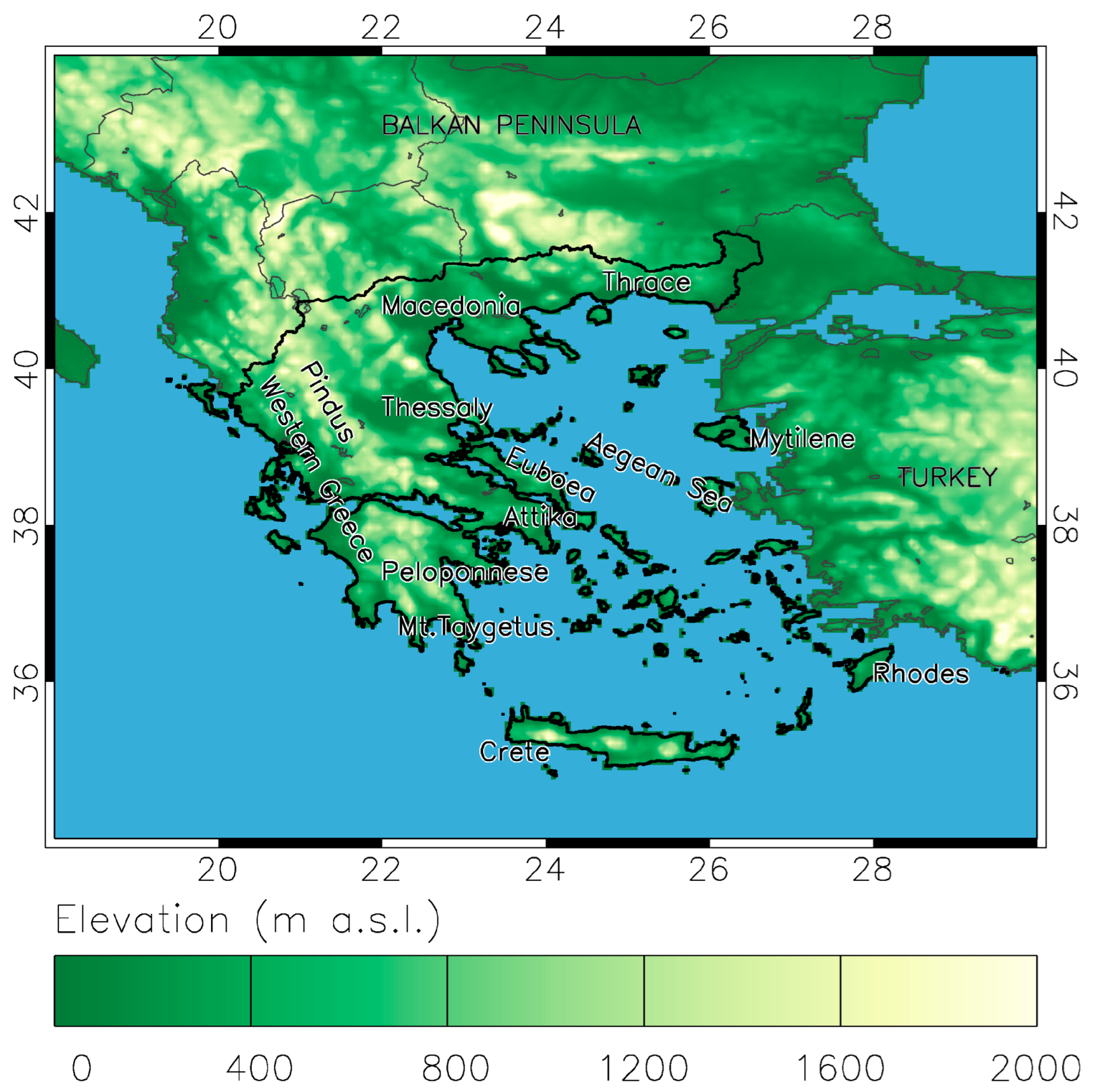
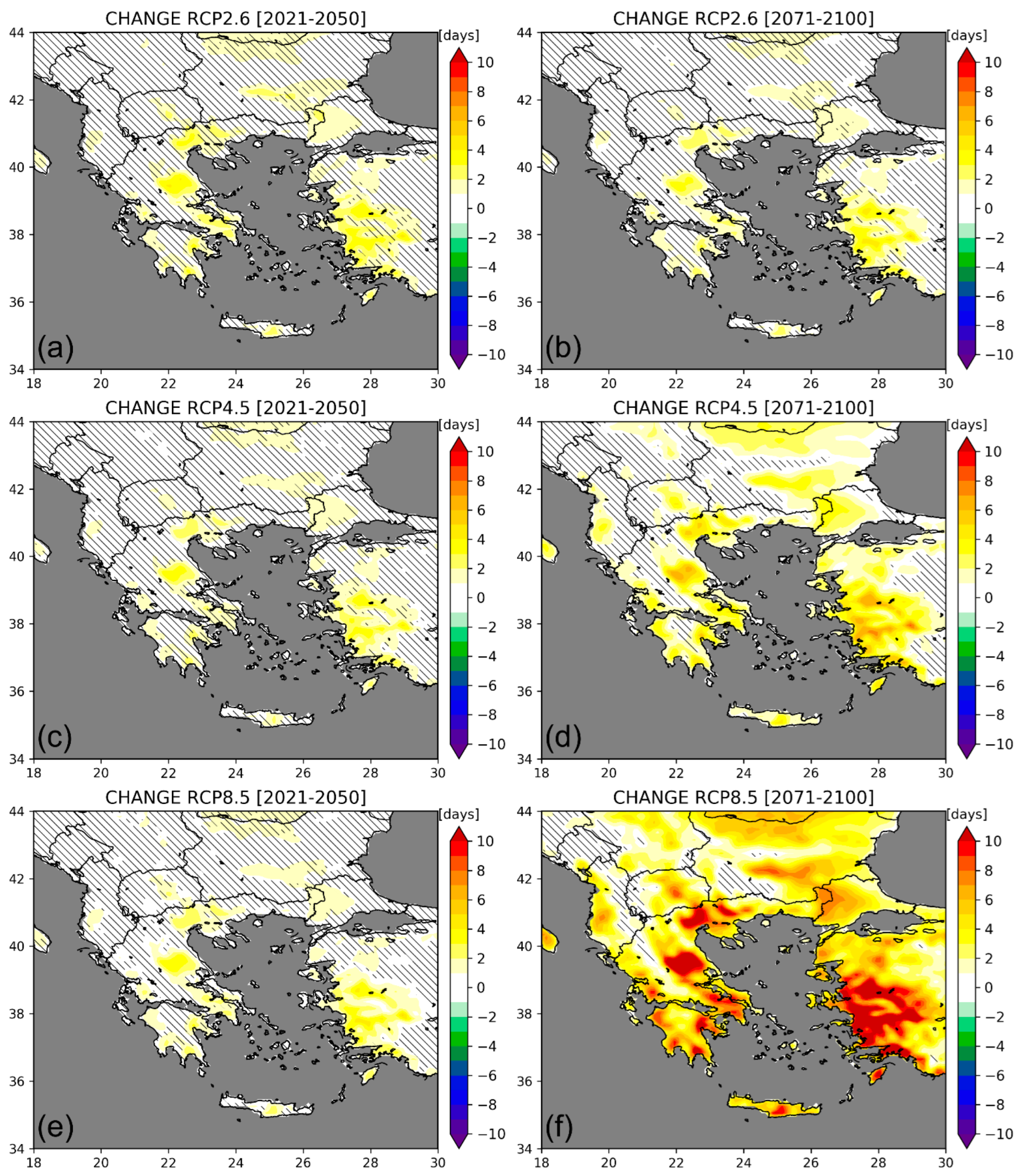
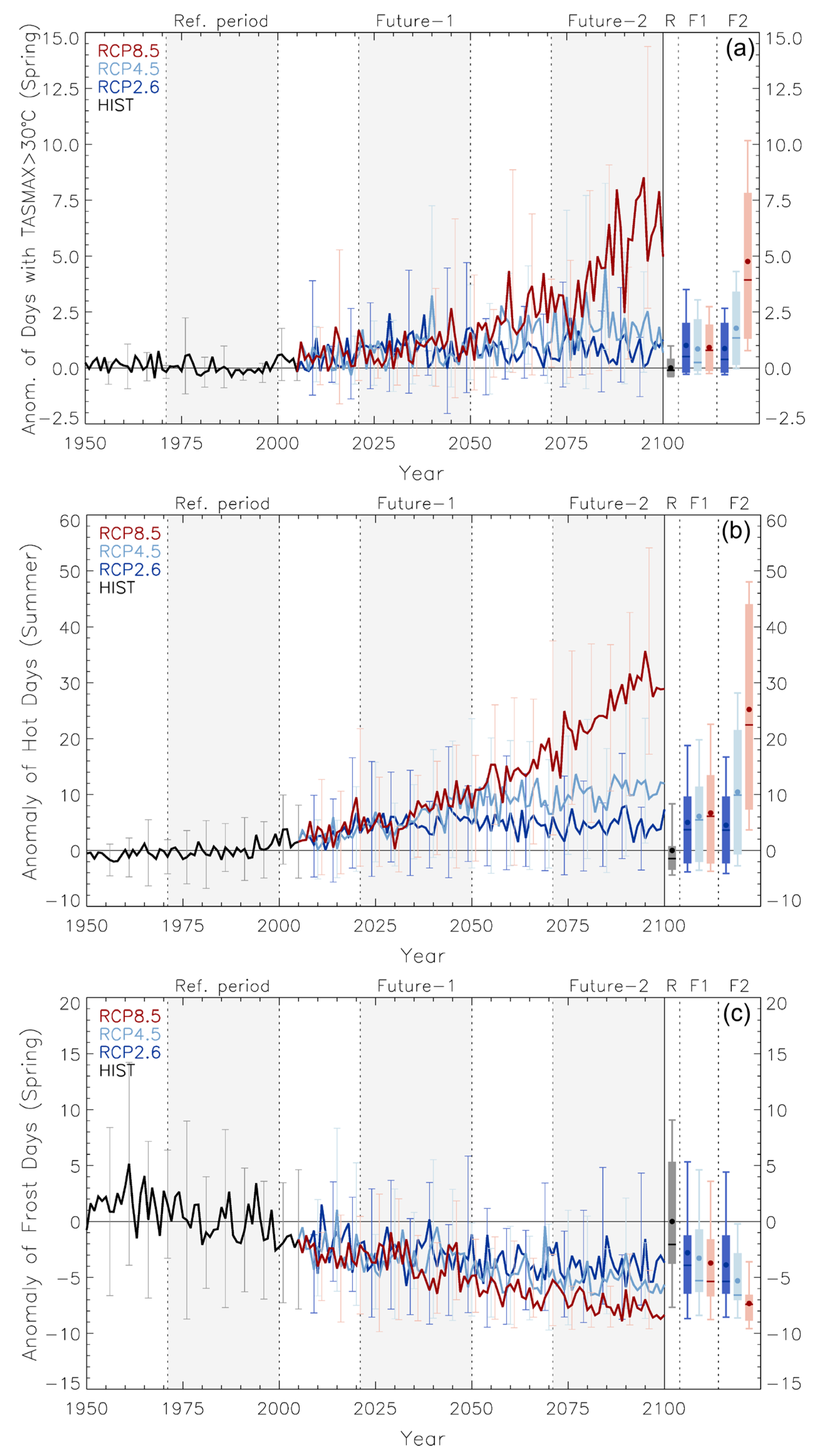
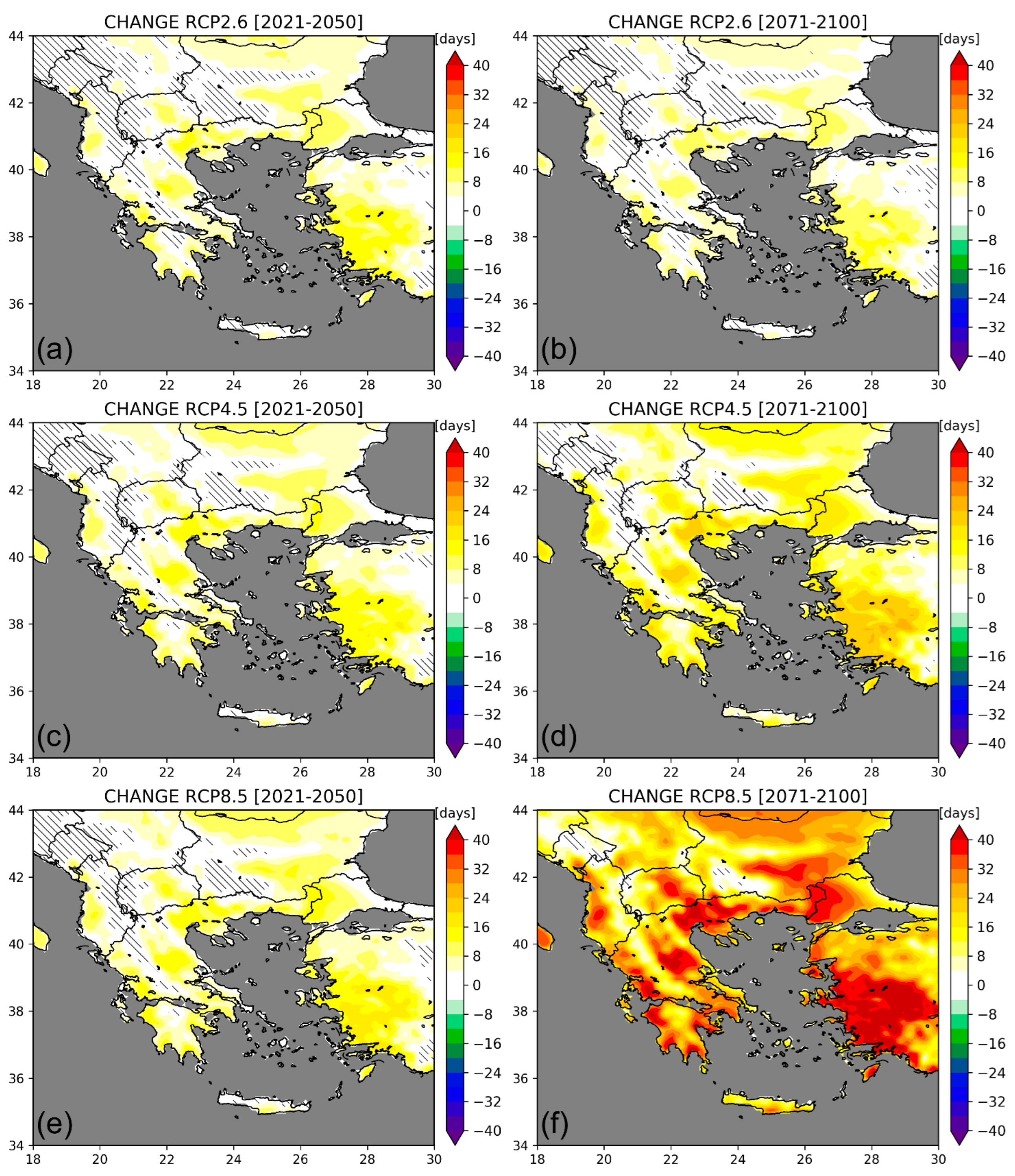
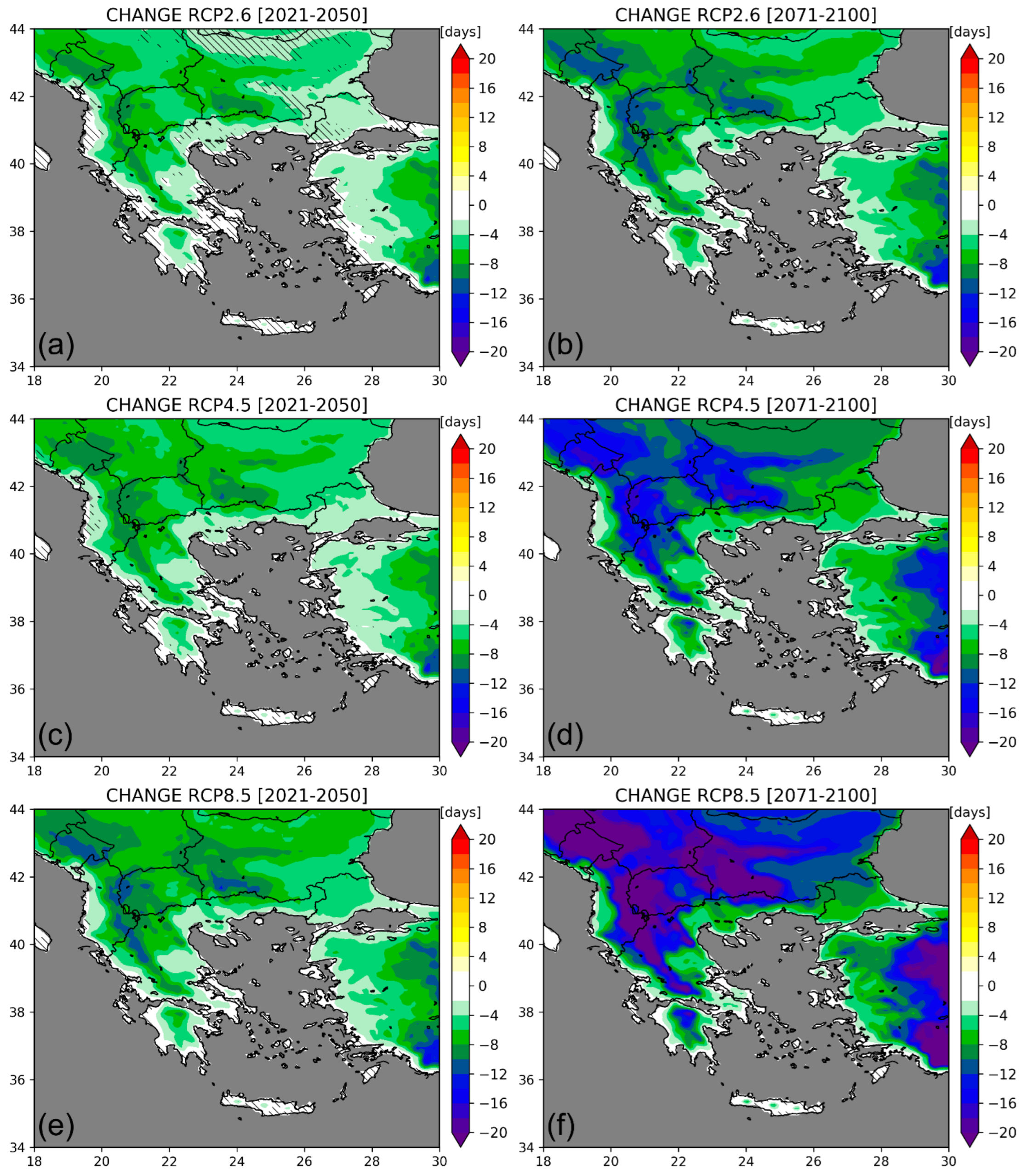
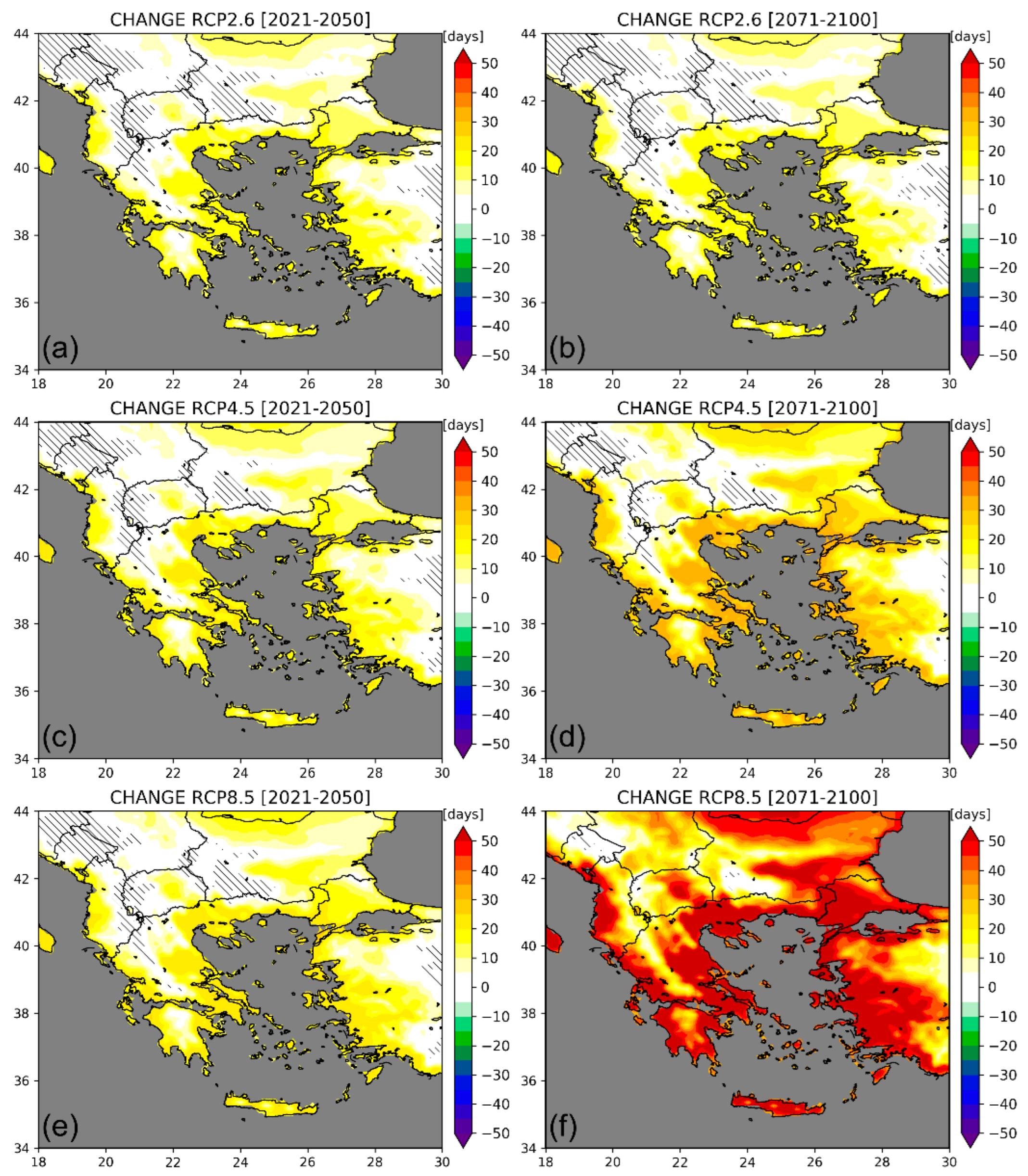
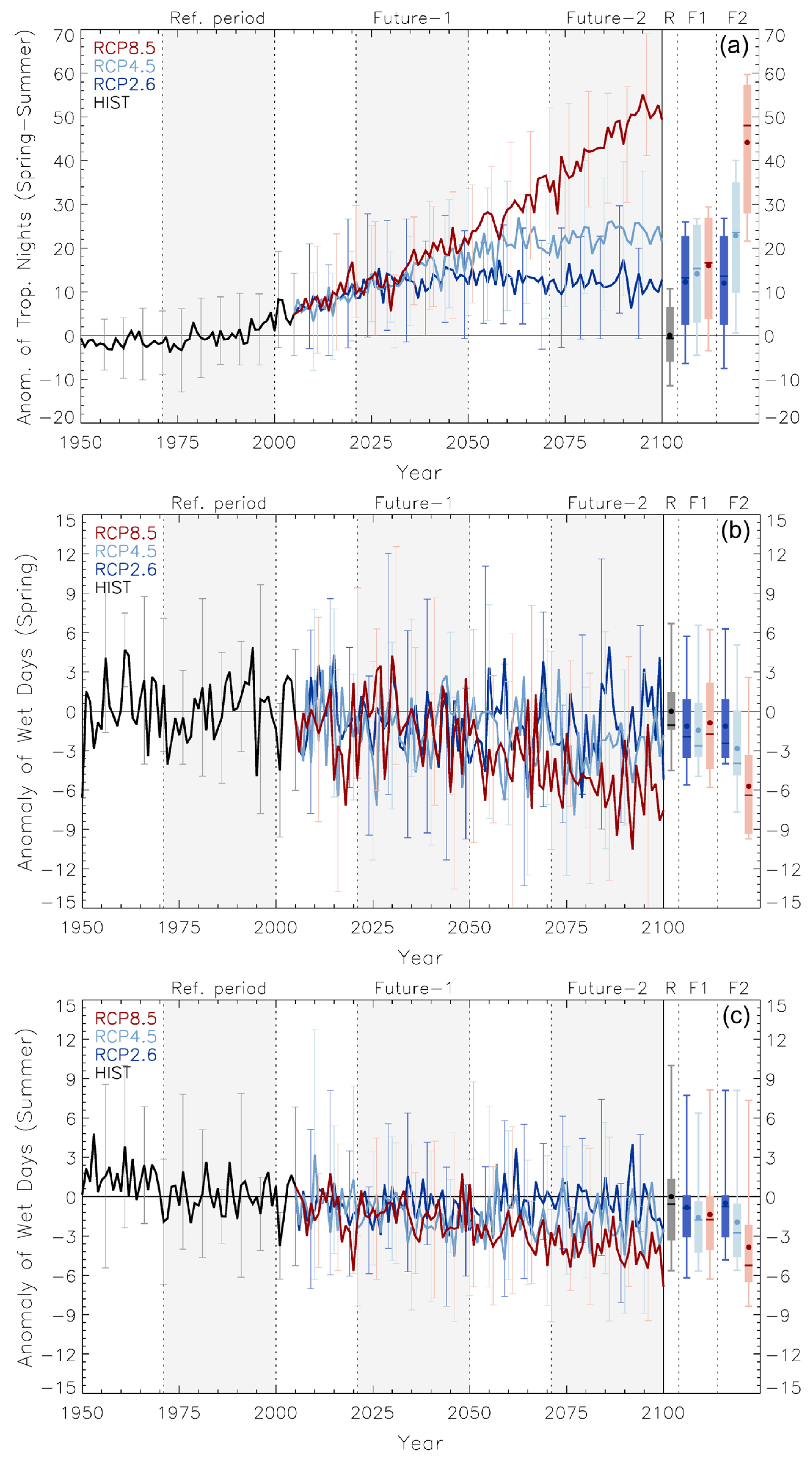
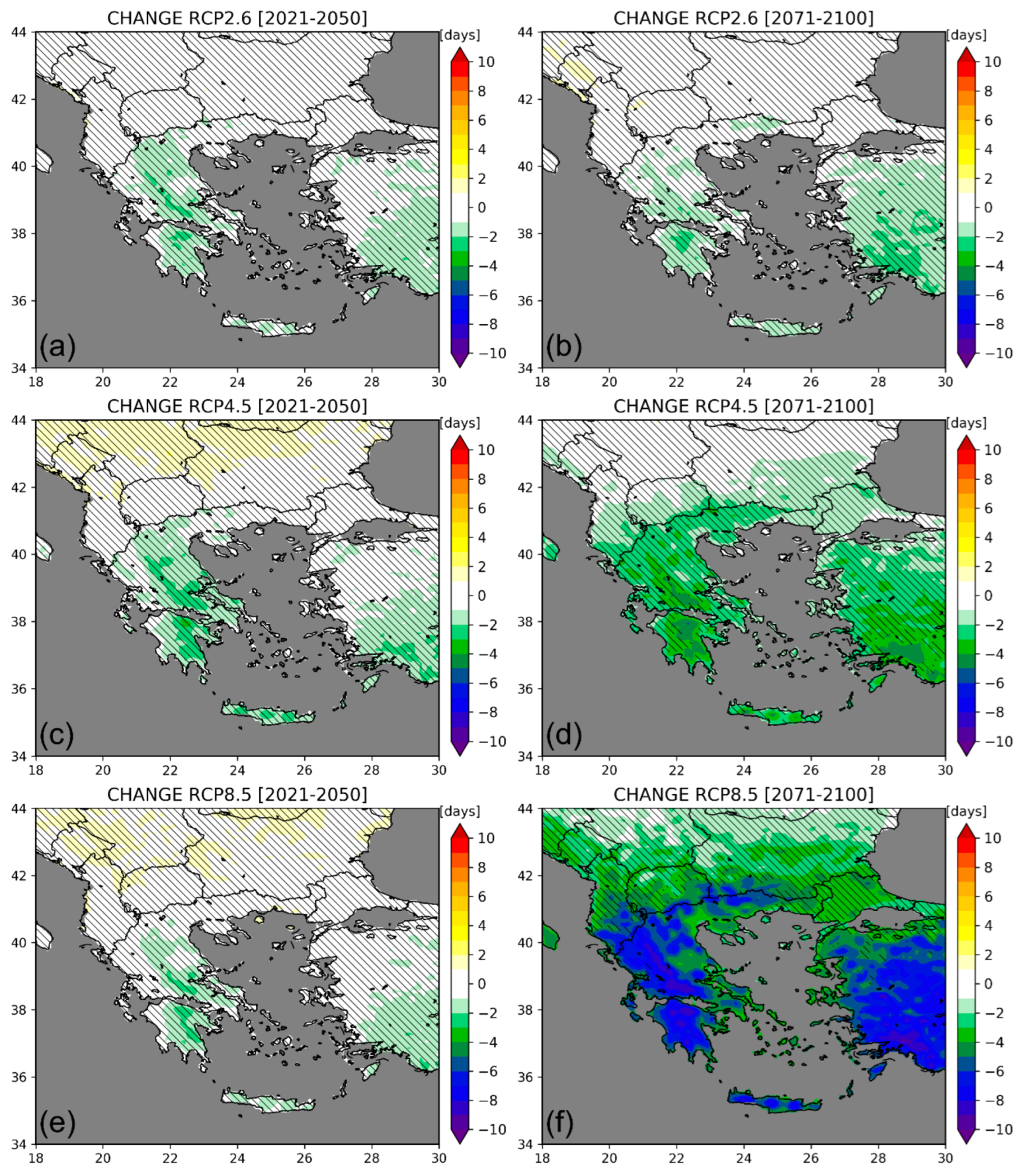
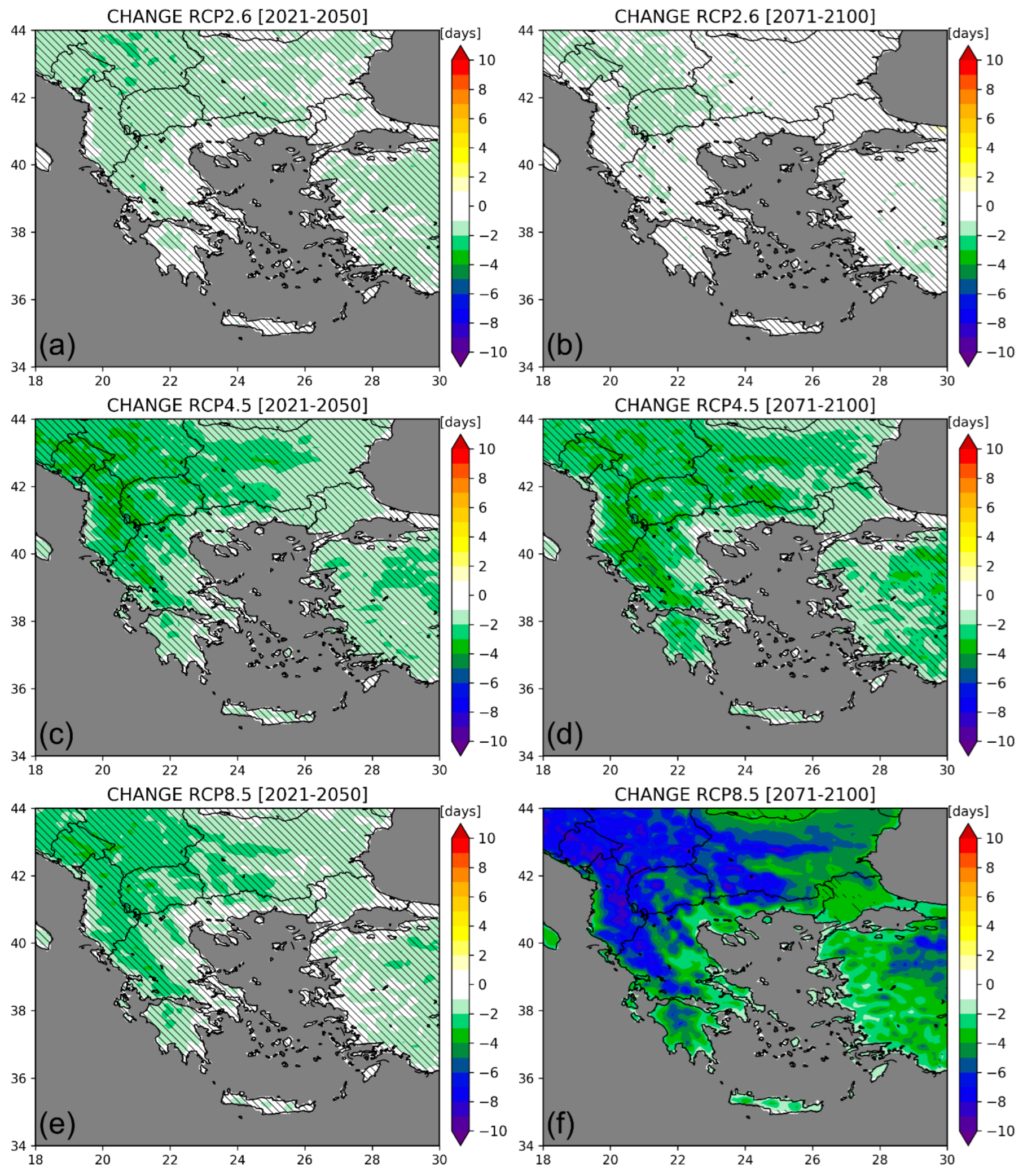
| RCM | Driving GCM | Realization | |
|---|---|---|---|
| 1 | ALADIN63.v2 | CNRM.CNRM-CERFACS-CNRM-CM5 | r1i1p1 |
| 2 | CCLM4-8-17.v1 | CLMcom.ICHEC-EC-EARTH | r12i1p1 |
| 3 | HIRHAM5.v2 | DMI.ICHEC-EC-EARTH | r3i1p1 |
| 4 | RACMO22E.v1 | KNMI.ICHEC-EC-EARTH | r12i1p1 |
| 5 | RACMO22E.v2 | KNMI.MOHC-HadGEM2-ES | r1i1p1 |
| 6 | RACMO22E.v2 | KNMI.CNRM-CERFACS-CNRM-CM5 | r1i1p1 |
| 7 | RCA4.v1 | SMHI.MOHC-HadGEM2-ES | r1i1p1 |
| 8 | RCA4.v1 | SMHI.MPI-M-MPI-ESM-LR | r1i1p1 |
| 9 | RCA4.v1 | SMHI.ICHEC-EC-EARTH | r12i1p1 |
| 10 | REMO2009.v1 | MPI-CSC.MPI-M-MPI-ESM-LR | r1i1p1 |
| 11 | REMO2009.v1 | MPI-CSC.MPI-M-MPI-ESM-LR | r2i1p1 |
Publisher’s Note: MDPI stays neutral with regard to jurisdictional claims in published maps and institutional affiliations. |
© 2022 by the authors. Licensee MDPI, Basel, Switzerland. This article is an open access article distributed under the terms and conditions of the Creative Commons Attribution (CC BY) license (https://creativecommons.org/licenses/by/4.0/).
Share and Cite
Mavromatis, T.; Georgoulias, A.K.; Akritidis, D.; Melas, D.; Zanis, P. Spatiotemporal Evolution of Seasonal Crop-Specific Climatic Indices under Climate Change in Greece Based on EURO-CORDEX RCM Simulations. Sustainability 2022, 14, 17048. https://doi.org/10.3390/su142417048
Mavromatis T, Georgoulias AK, Akritidis D, Melas D, Zanis P. Spatiotemporal Evolution of Seasonal Crop-Specific Climatic Indices under Climate Change in Greece Based on EURO-CORDEX RCM Simulations. Sustainability. 2022; 14(24):17048. https://doi.org/10.3390/su142417048
Chicago/Turabian StyleMavromatis, Theodoros, Aristeidis K. Georgoulias, Dimitris Akritidis, Dimitris Melas, and Prodromos Zanis. 2022. "Spatiotemporal Evolution of Seasonal Crop-Specific Climatic Indices under Climate Change in Greece Based on EURO-CORDEX RCM Simulations" Sustainability 14, no. 24: 17048. https://doi.org/10.3390/su142417048
APA StyleMavromatis, T., Georgoulias, A. K., Akritidis, D., Melas, D., & Zanis, P. (2022). Spatiotemporal Evolution of Seasonal Crop-Specific Climatic Indices under Climate Change in Greece Based on EURO-CORDEX RCM Simulations. Sustainability, 14(24), 17048. https://doi.org/10.3390/su142417048













